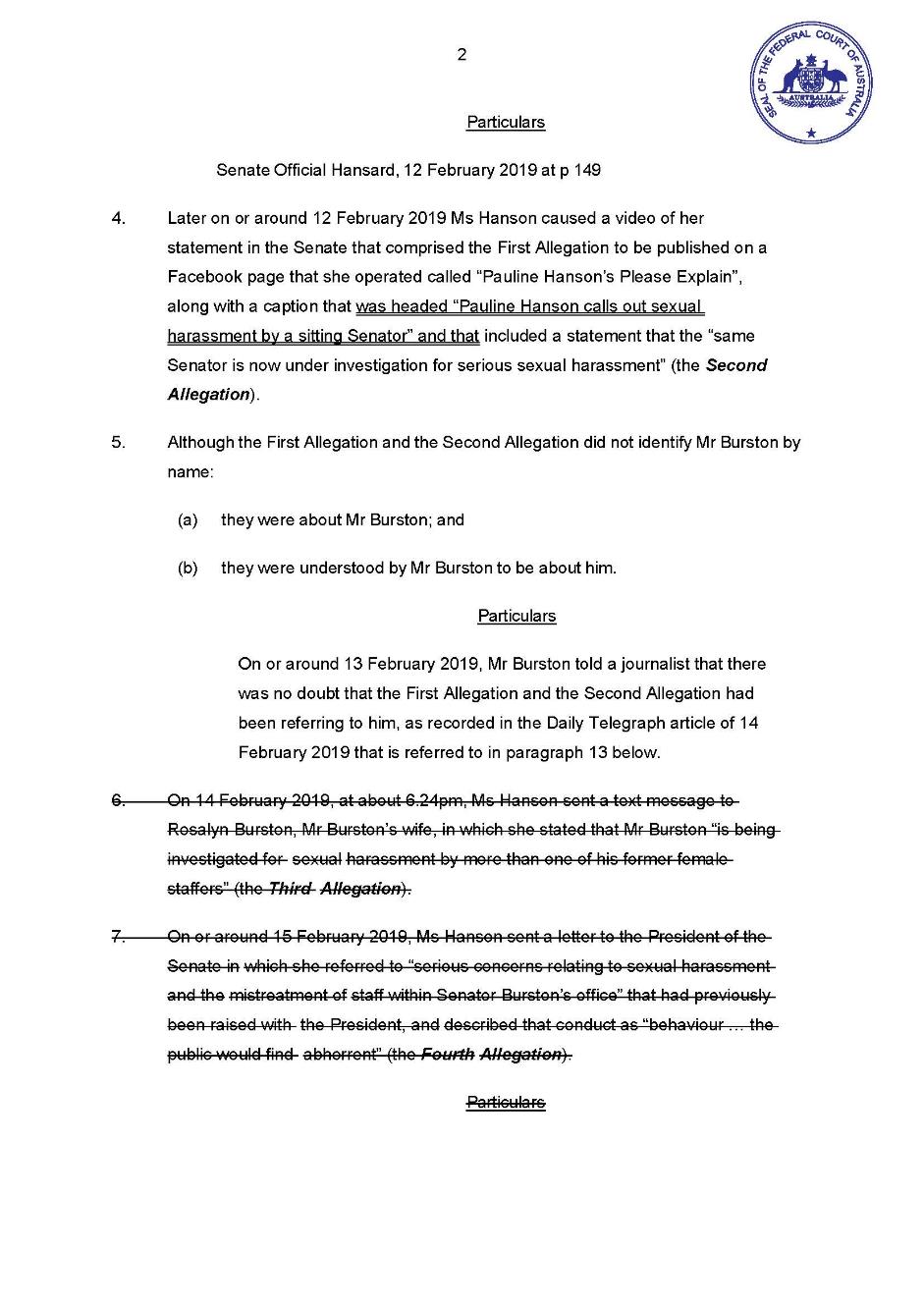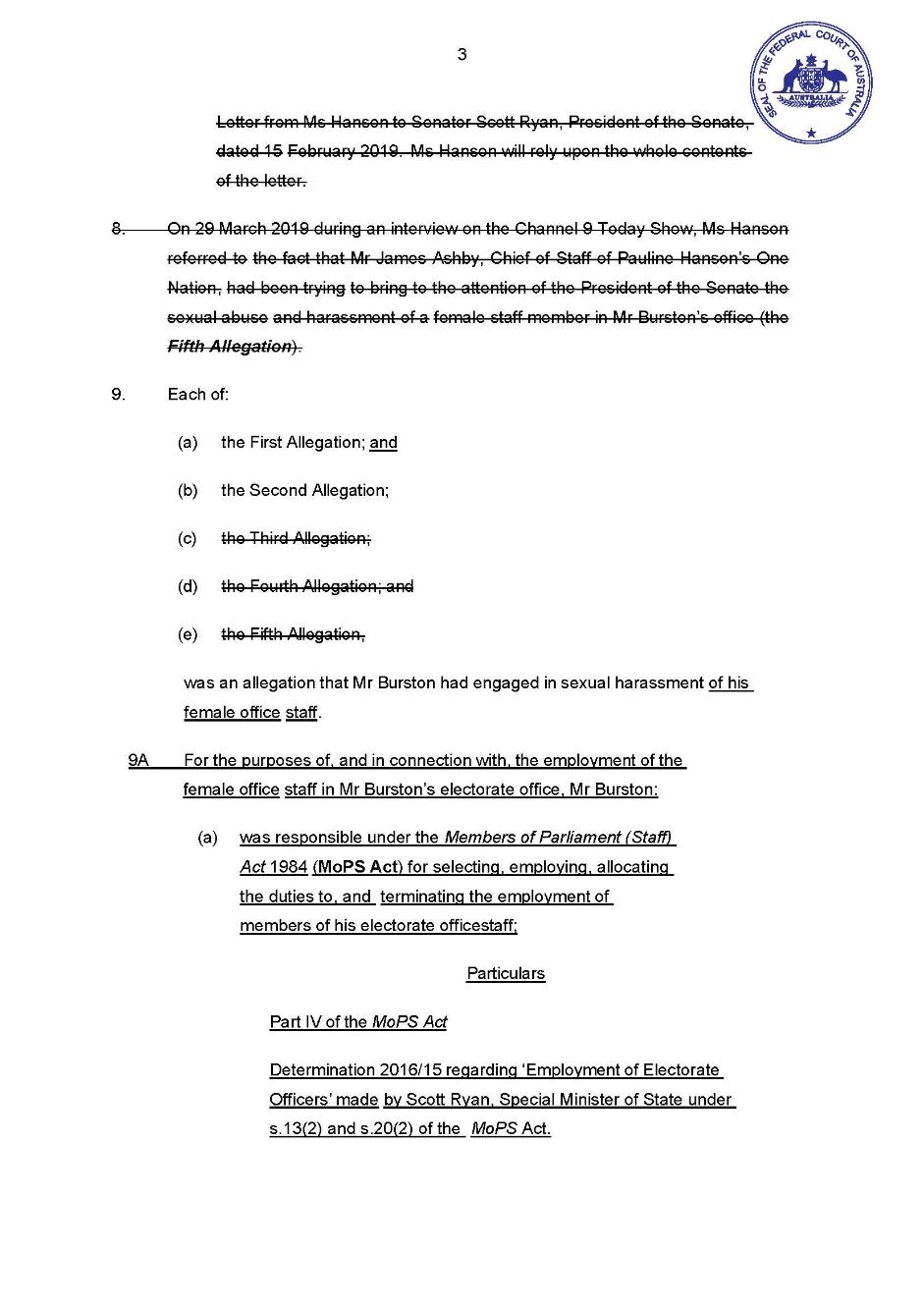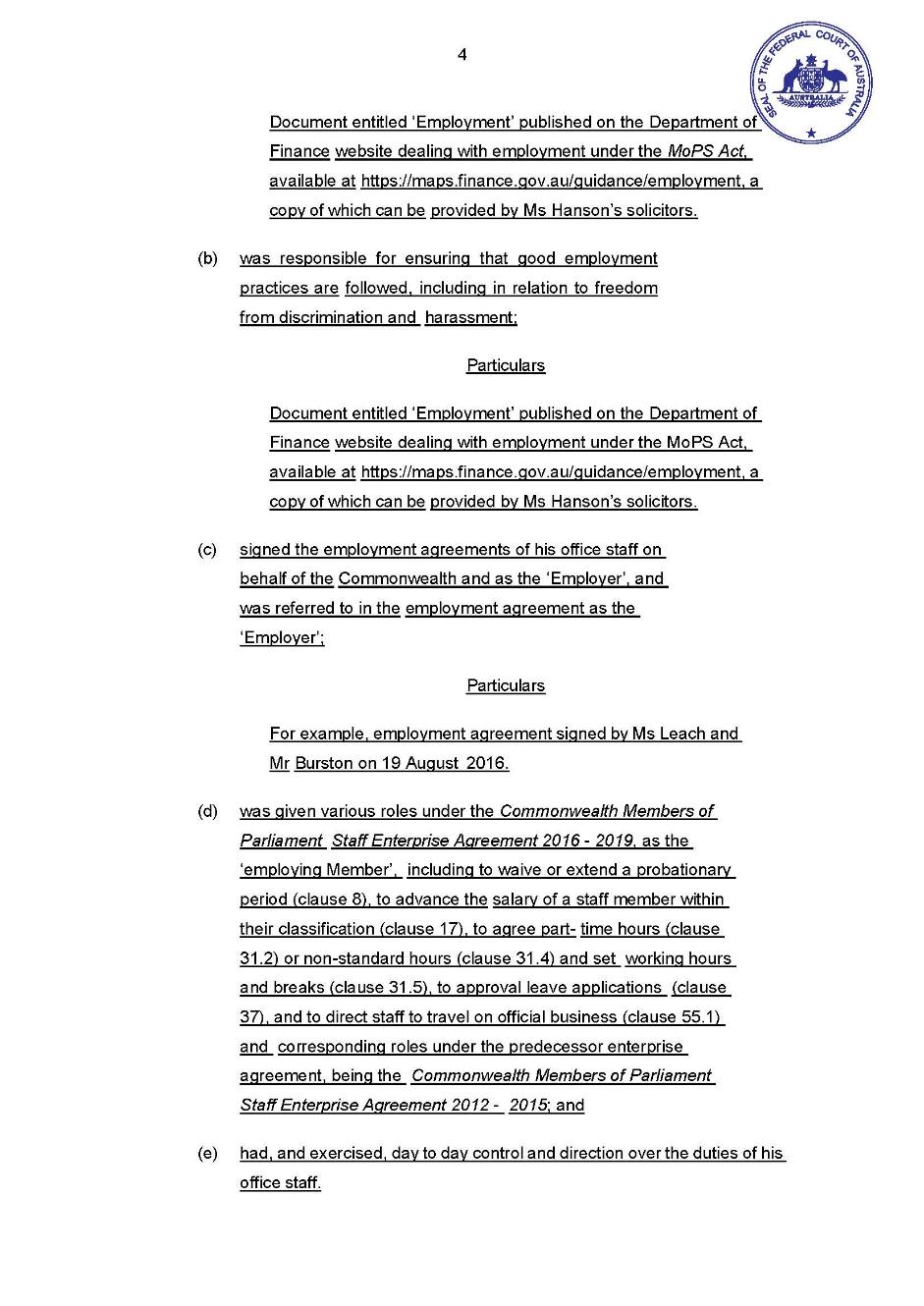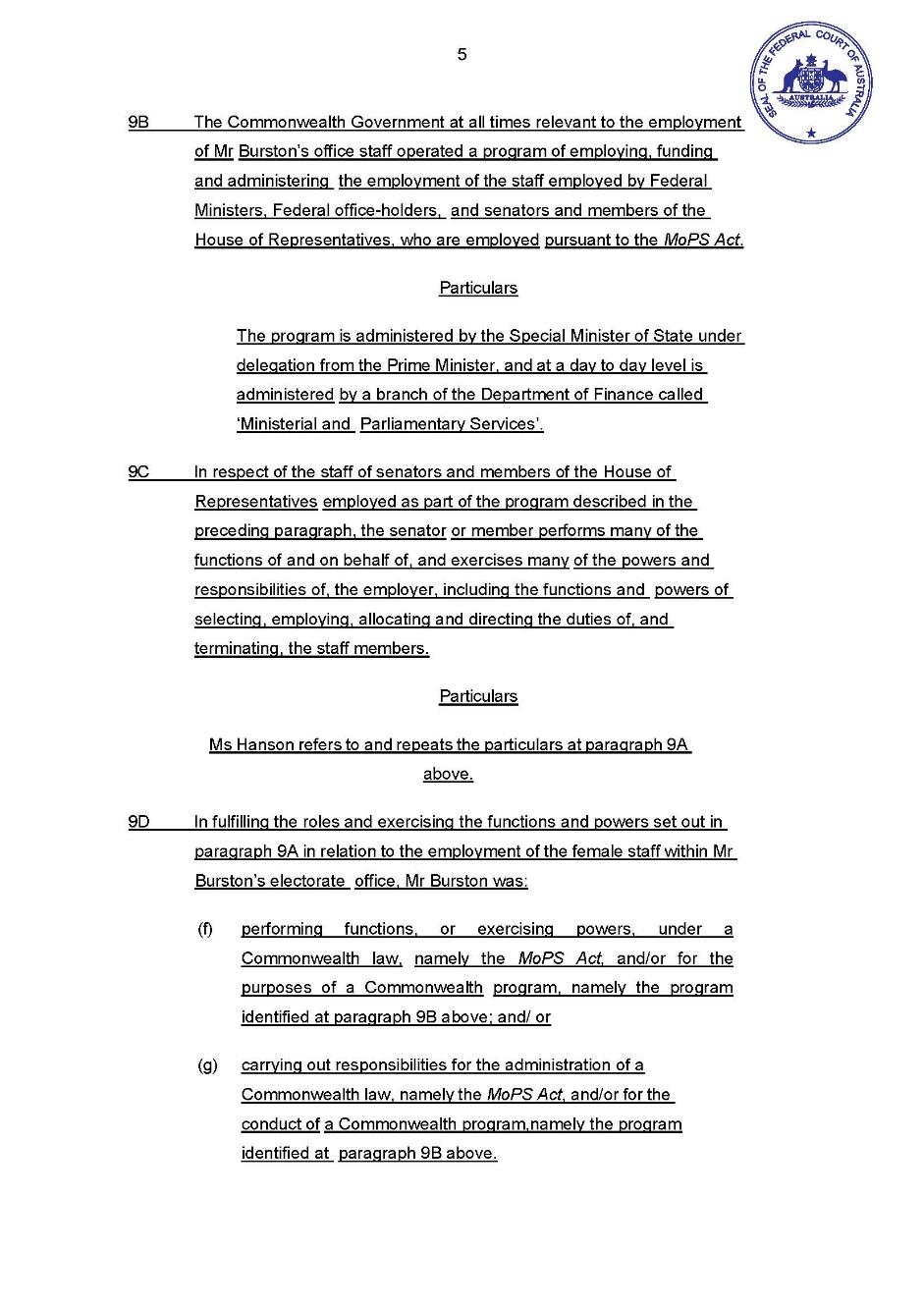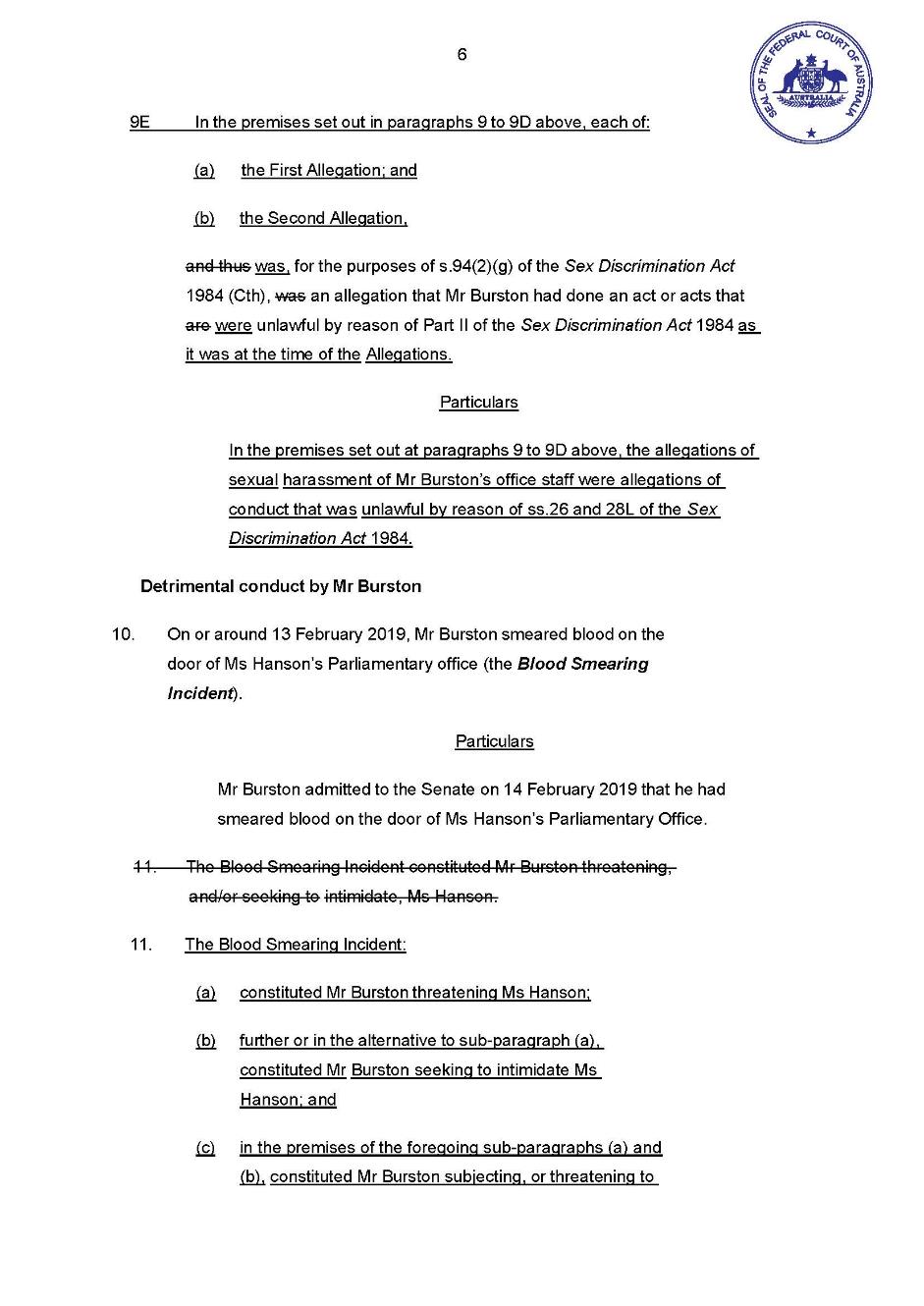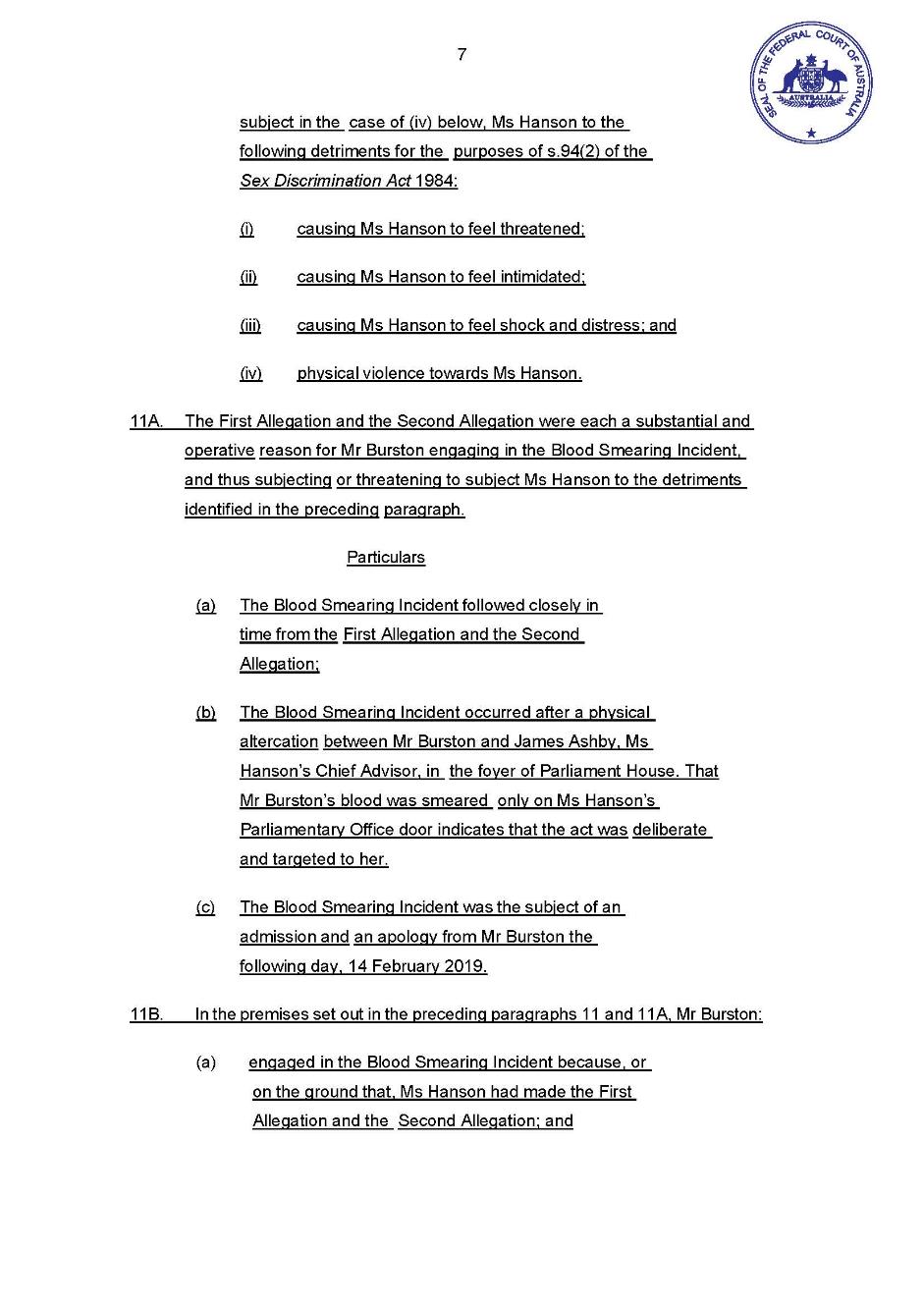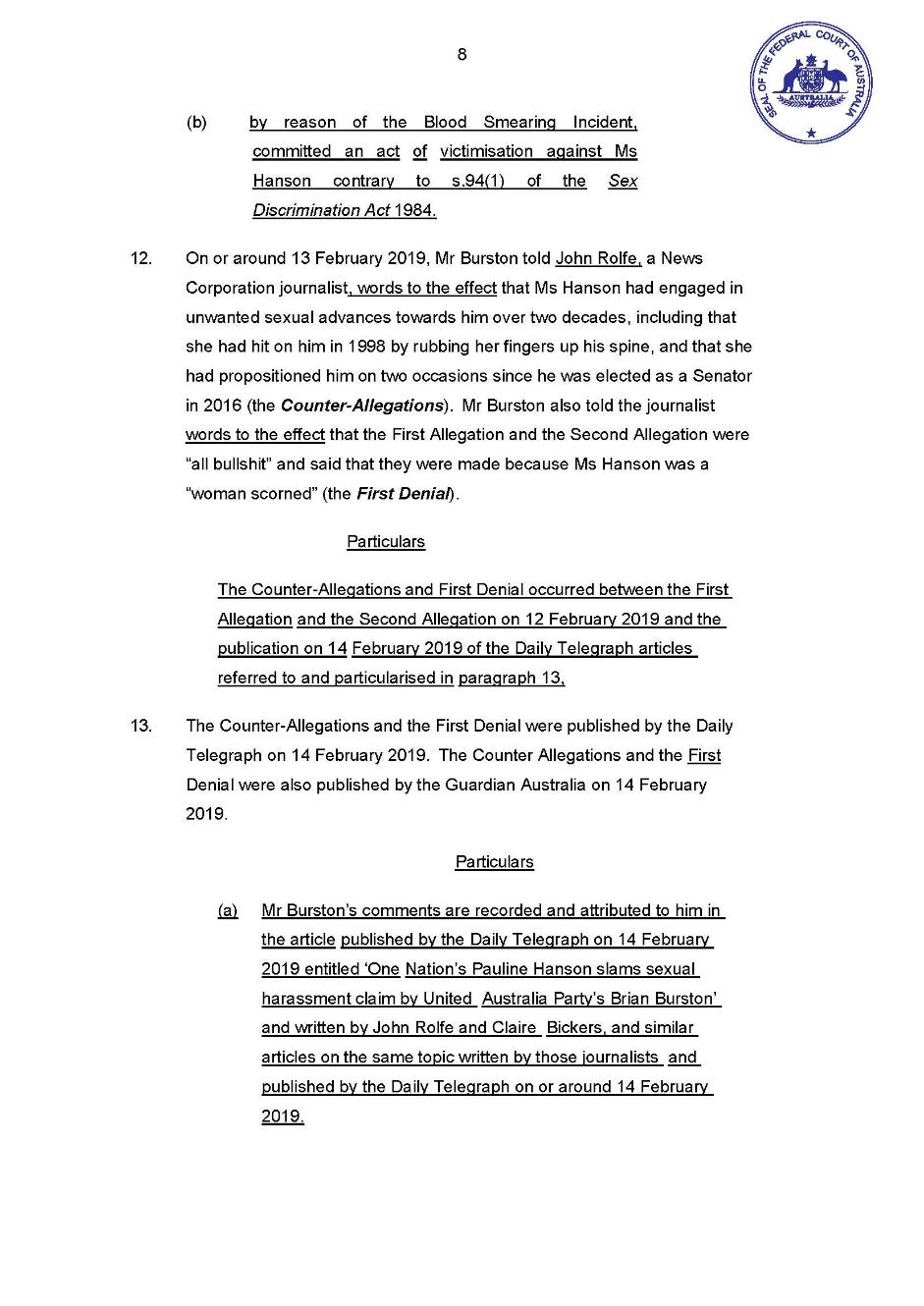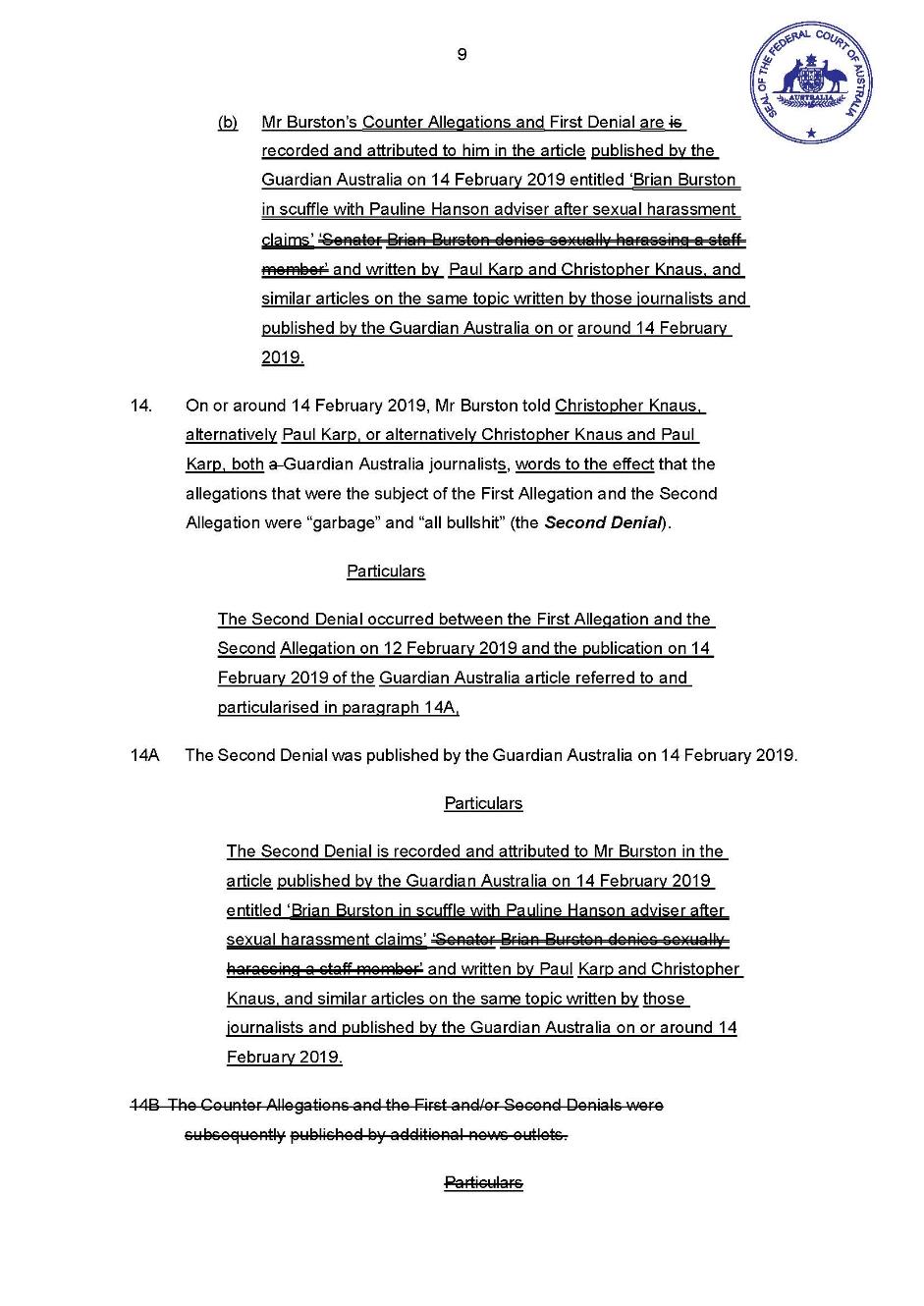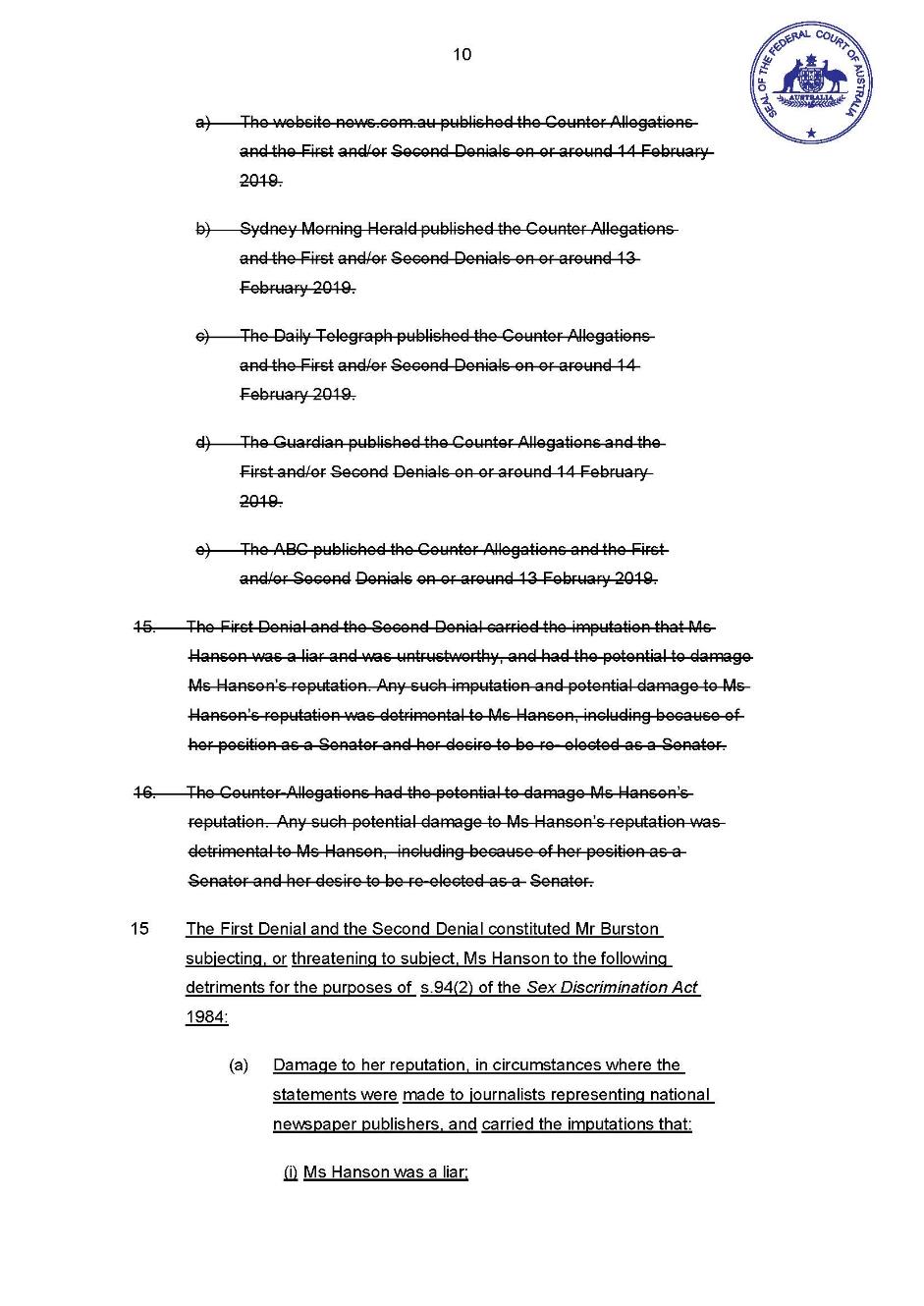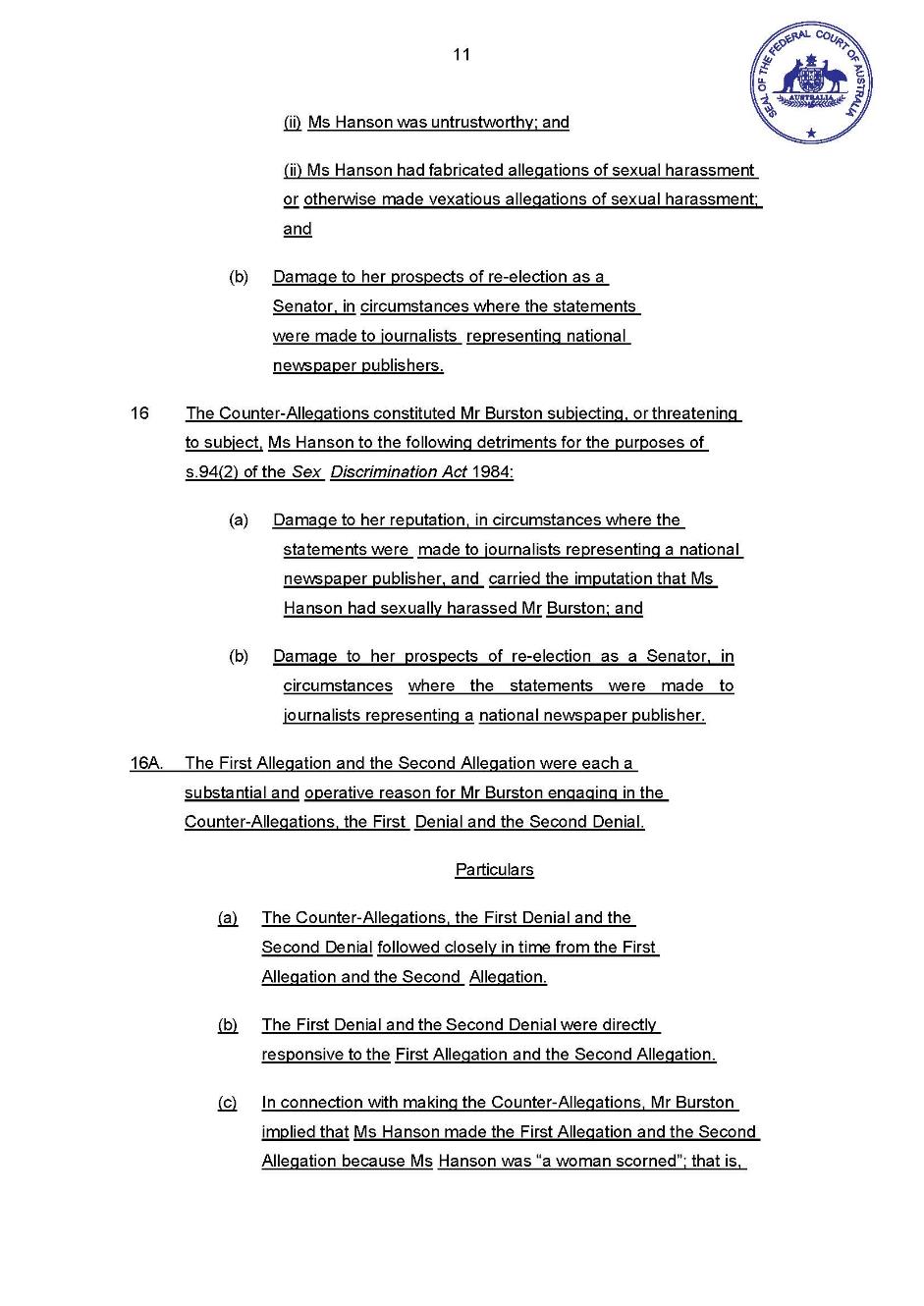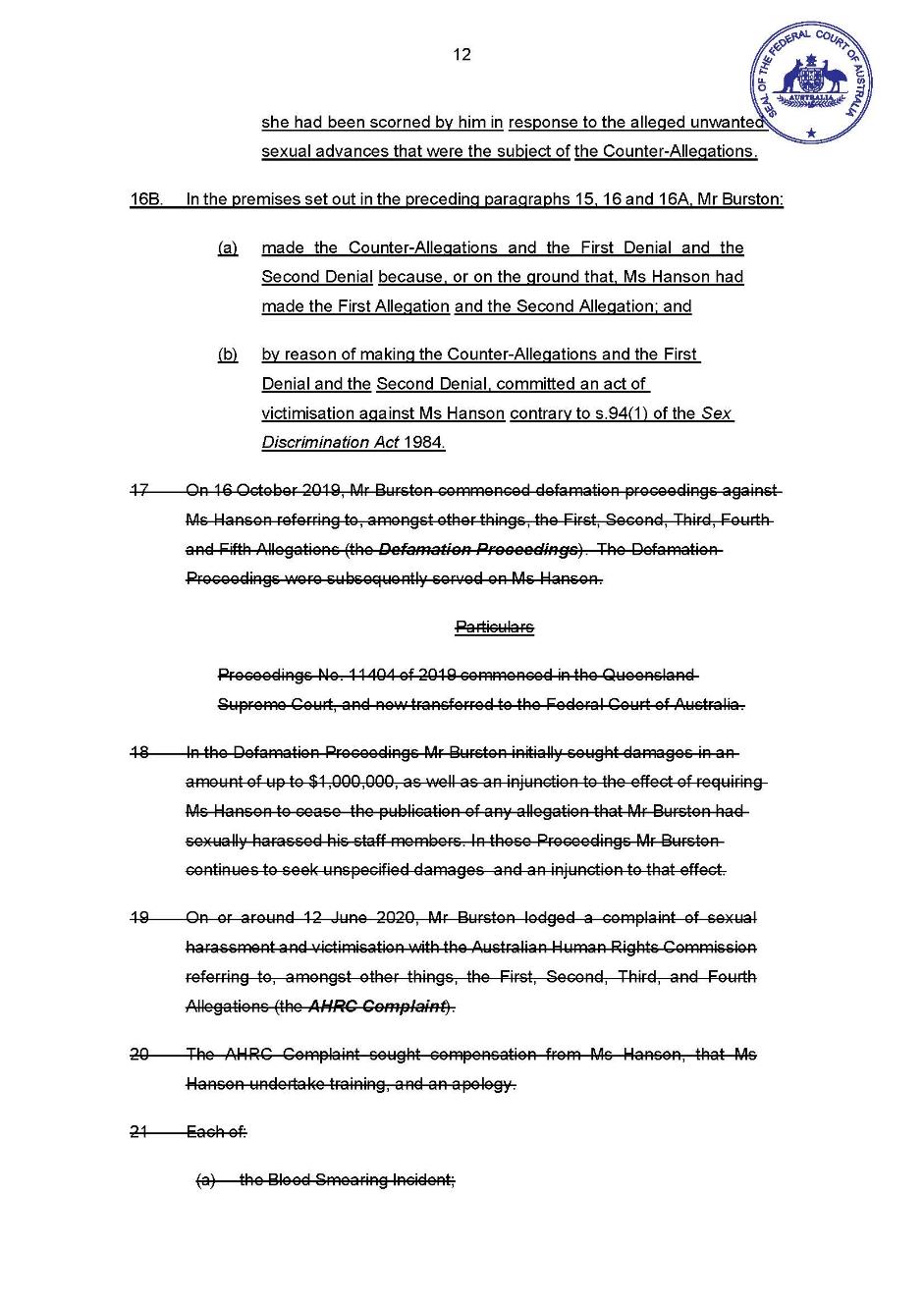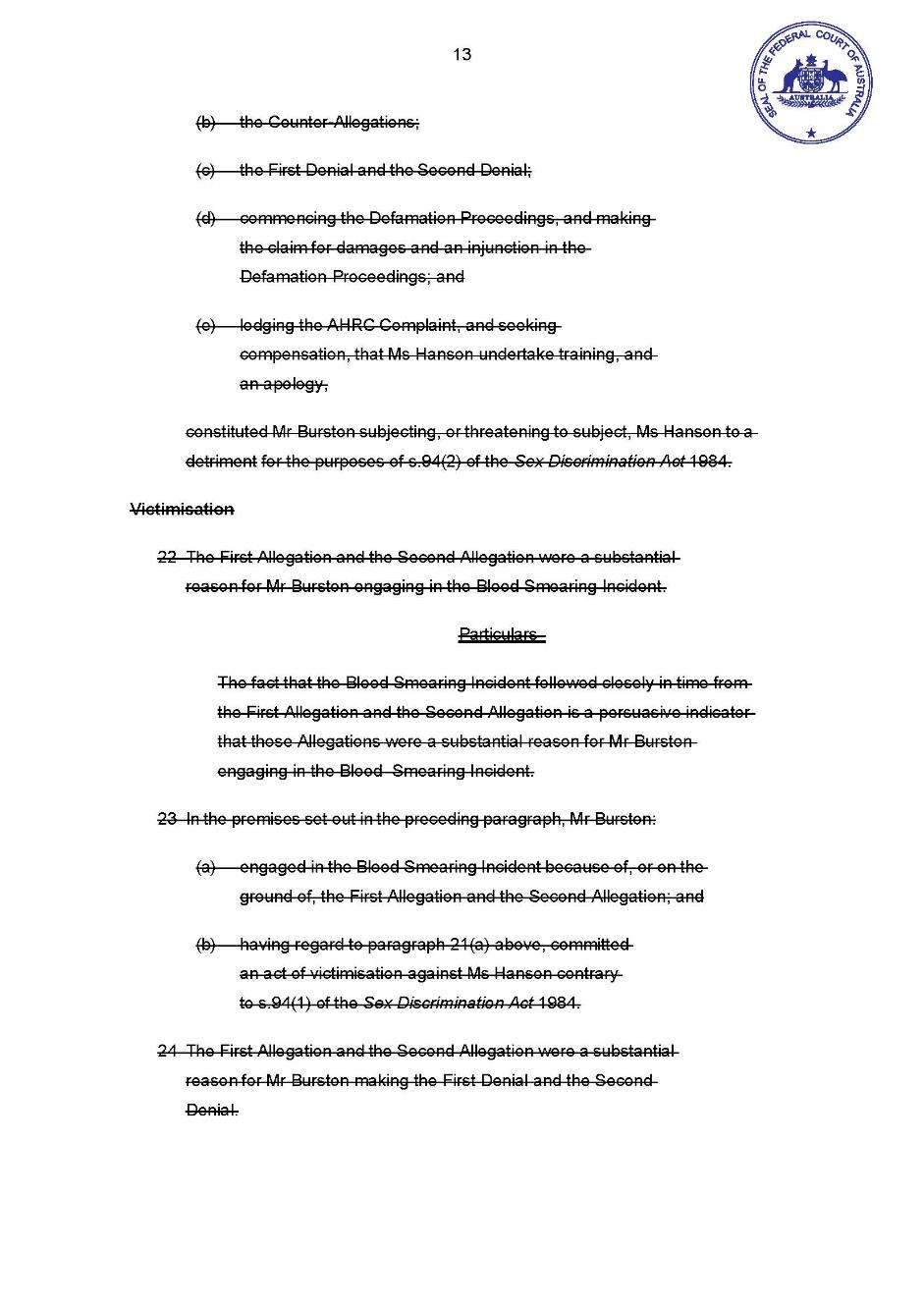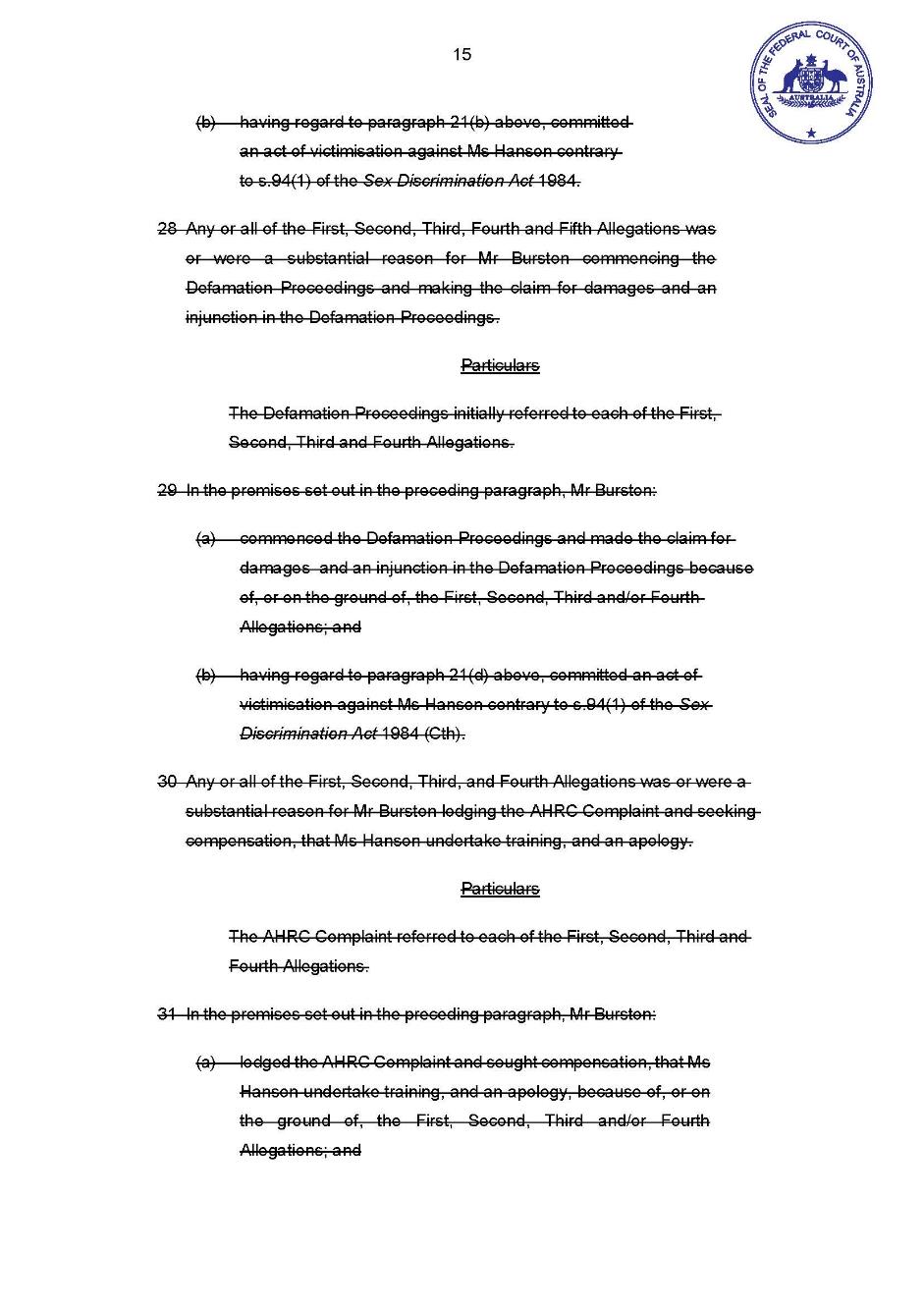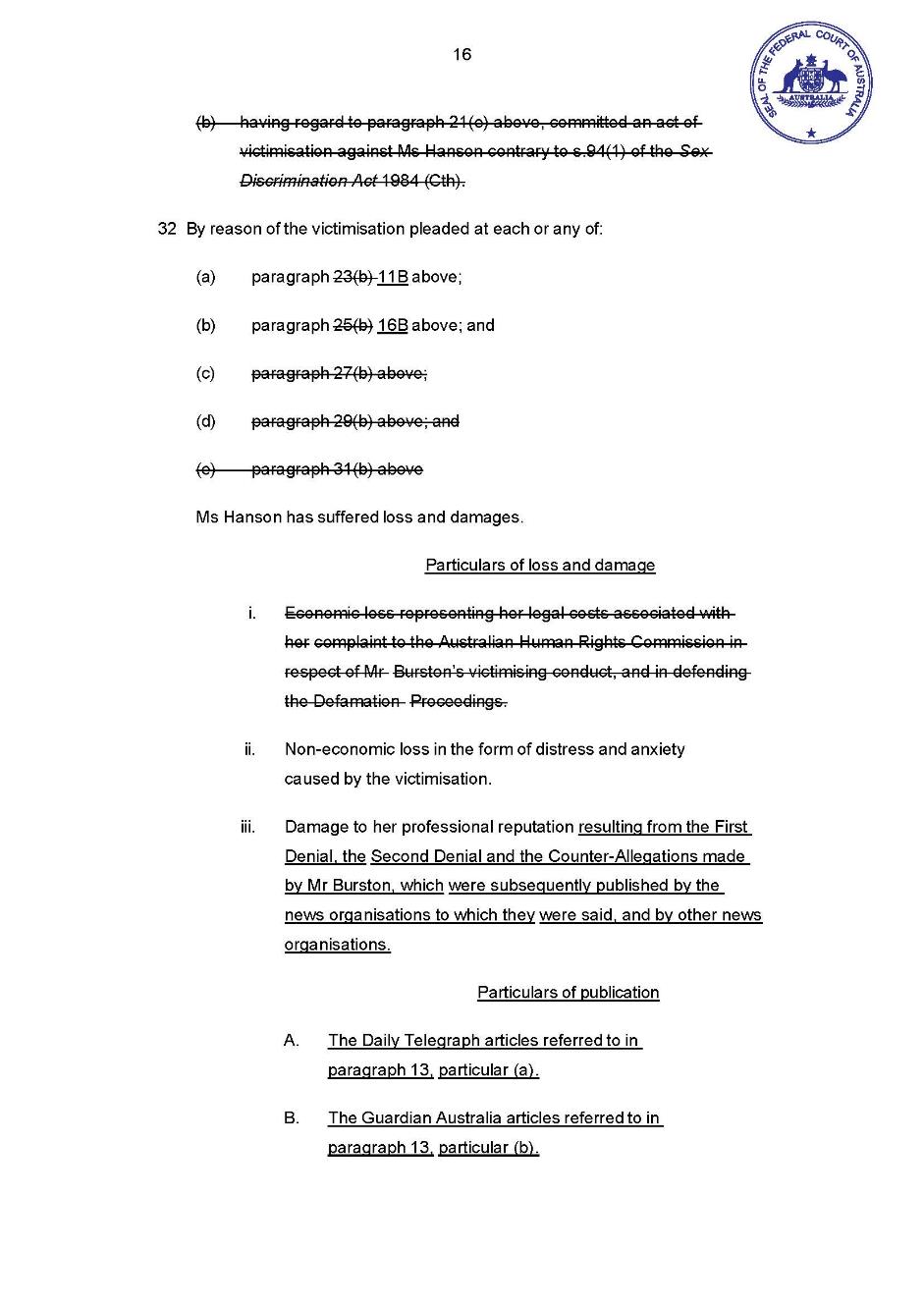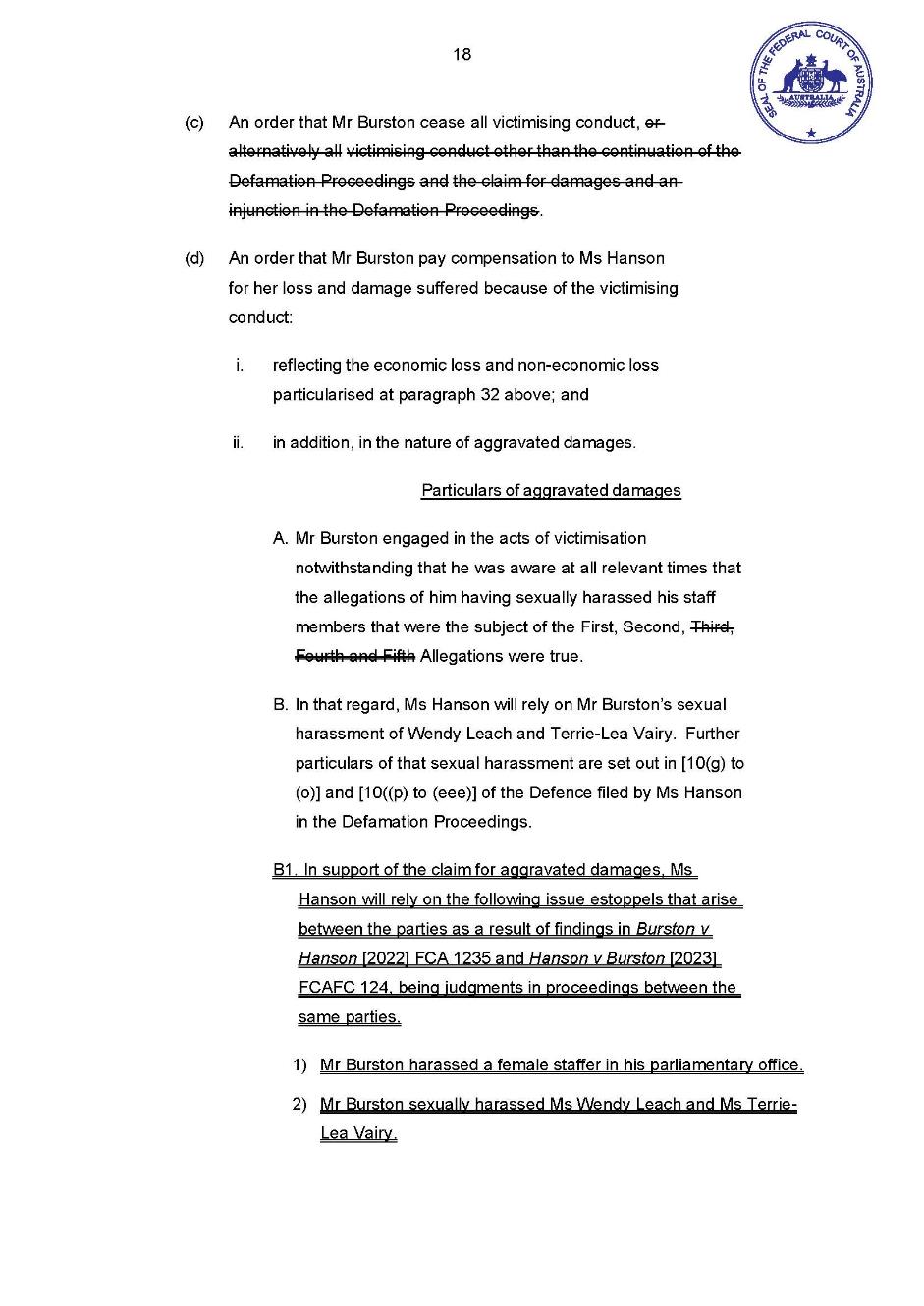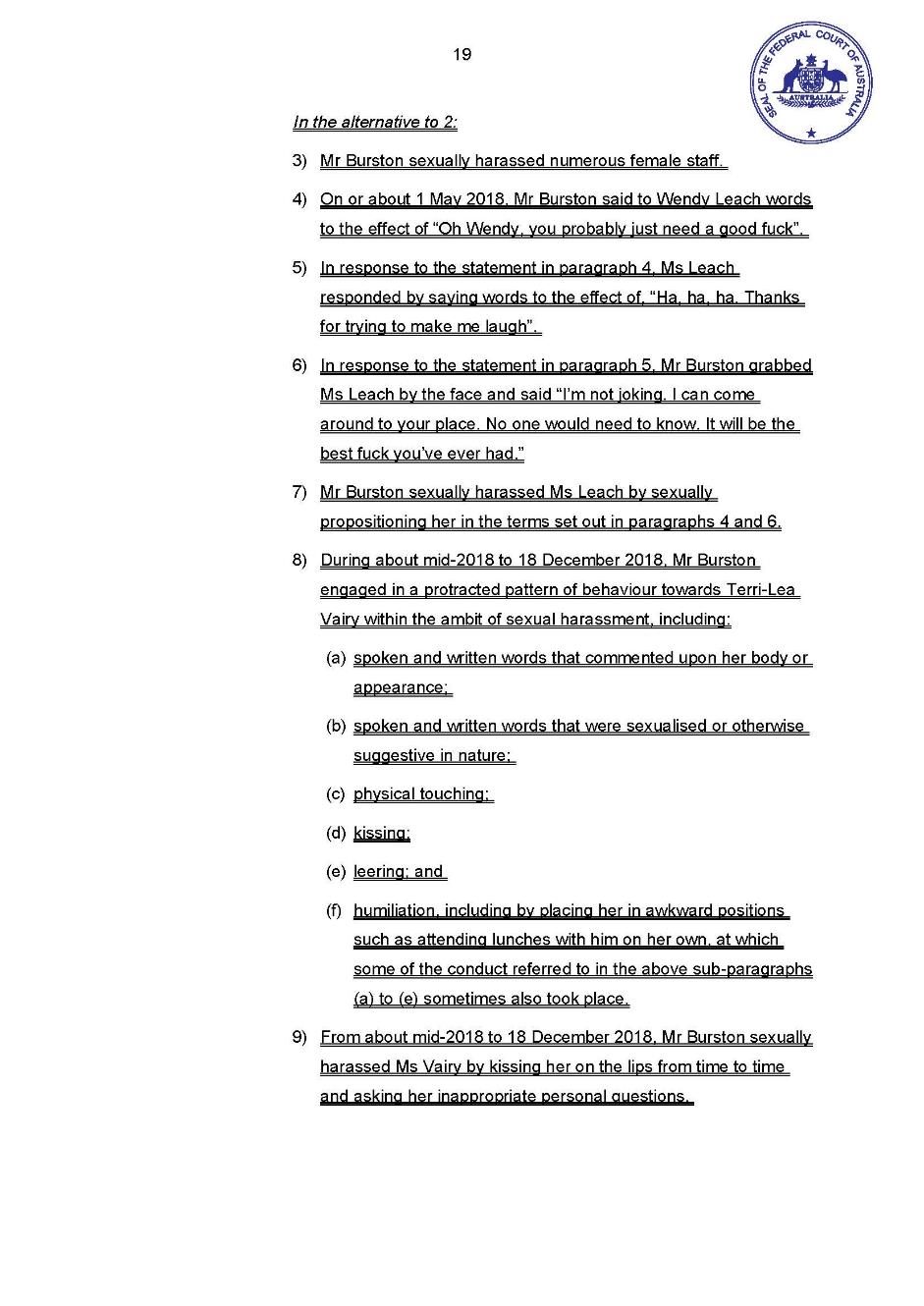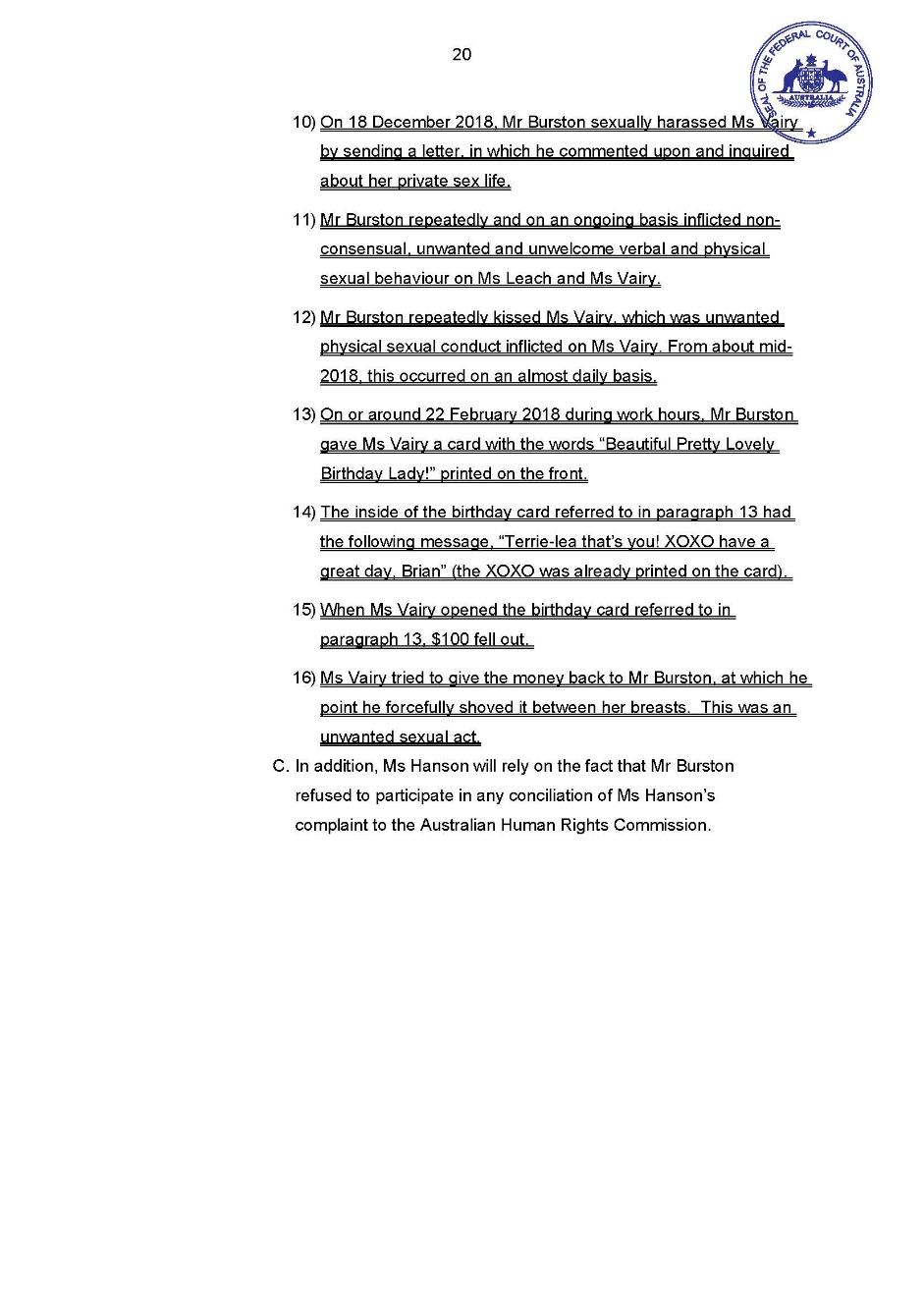Federal Court of Australia
Hanson v Burston (No 3) [2025] FCA 761
File number(s): | NSD 1210 of 2020 |
Judgment of: | YOUNAN J |
Date of judgment: | 11 July 2025 |
Catchwords: | PRACTICE AND PROCEDURE – application to amend points of claim under r 16.53 of the Federal Court Rules 2011 (Cth) to provide further particulars of an existing claim – where proposed amendment introduces a claim for issue estoppel – whether issue estoppel should be specifically pleaded – distinction between pleadings and particulars – where proposed amendments are not futile and no prejudice to opposing party is established – application granted PRACTICE AND PROCEDURE – application under r 30.25 of the Federal Court Rules 2011 (Cth) to admit transcript evidence taken in another proceeding – where potential witness is reluctant to provide oral evidence – where relevance and utility of proposed evidence not established – application dismissed |
Legislation: | Australian Human Rights Commission Act 1986 (Cth) ss 46P, 46PO Federal Court of Australia Act 1976 (Cth) s 23 Parliamentary Privileges Act 1987 (Cth) s 16 Sex Discrimination Act 1984 (Cth) s 94 Federal Court Rules 2011 (Cth) rr 16.02, 16.41, 16.53, 30.25 |
Cases cited: | Blair v Curran (1939) 62 CLR 464 Burston v Hanson [2022] FCA 1235 Caason Investments Pty Ltd v Cao [2015] FCAFC 94; (2015) 236 FCR 322 Dare v Pullham (1982) 148 CLR 658 Effem Foods Pty Ltd v Trawl Industries of Australia Pty Ltd (in liq) (1993) 43 FCR 510 Feltham v St Vincent’s Public Hospital [1993] NSWCA 95 at 17 Hanson v Burston [2022] FCA 1235 Hanson v Burston [2023] FCAFC 124 Hanson-Young v Leyonhjelm [2018] FCA 1688 Laws Holdings Pty Ltd v Short (1972) 46 ALJR 563 Medich v Bentley-Smythe Pty Ltd [2010] FCA 494 Plaintiff P1/2023 v Ruddock [2007] FCA 65; (2007) 157 FCR 518 Queensland v Pioneer Concrete (Qld) Pty Ltd [1999] FCA 499 Re Sterling; Ex parte Essanda Ltd [1980] FCA 75; (1980) 30 ALR 77 Research in Motion Ltd v Samsung Electronics Australia Pty Ltd [2009] FCA 320; (2009) 176 FCR 66 Sadiqi v Commonwealth (No 2) [2009] FCA 1117; (2009) 181 FCR 1 Tamaya Resources Limited (in liq) v Deloitte Touche Tohmatsu (A Firm) [2016] FCAFC 2; (2016) 332 ALR 199 Tamaya Resources Limited (in liq) v Deloitte Touche Tohmatsu (A Firm), in the matter of Tamaya Resources Limited (in liq) [2015] FCA 1098 Telnet Pty Limited v Takapana Investments Pty Limited (1994) 51 FCR 520 Tickle v Giggle for Girls Pty Ltd (No 2) [2024] FCA 960 Voxson Pty Ltd v Telstra Corporation Limited (No 7) [2017] FCA 267; (2017) 343 ALR 681 |
J D Heydon, Cross on Evidence (14th ed, LexisNexis Butterworths, 2024) | |
Division: | General Division |
Registry: | New South Wales |
National Practice Area: | Administrative and Constitutional Law and Human Rights |
Number of paragraphs: | 78 |
Date of hearing: | 23 June 2025 |
Counsel for the Applicant: | Mr P Moorehouse with Ms R Kumar |
Solicitor for the Applicant: | Harmers Workplace Lawyers |
Counsel for the Respondent: | Ms K Eastman with Mr R Lee |
Solicitor for the Respondent: | MinterEllison |
ORDERS
NSD 1210 of 2020 | ||
| ||
BETWEEN: | PAULINE HANSON Applicant | |
AND: | BRIAN BURSTON Respondent | |
order made by: | YOUNAN J |
DATE OF ORDER: | 11 July 2025 |
THE COURT ORDERS THAT:
1. The applicant be granted leave to file and serve the Second Further Amended Points of Claim in the form annexed hereto.
2. The applicant’s interlocutory application seeking leave to read the oral evidence of Terrie-Lea Vairy taken in proceeding NSD 652 of 2020, pursuant to r 30.25 of the Federal Court Rules 2011 (Cth), be dismissed.
3. Costs be reserved.
Note: Entry of orders is dealt with in Rule 39.32 of the Federal Court Rules 2011.
REASONS FOR JUDGMENT
YOUNAN J:
1 By interlocutory application filed on 5 February 2025, the applicant (Senator Pauline Hanson) seeks:
(1) leave to file and serve the Second Further Amended Points of Claim (Statement of Claim Application); and
(2) an order pursuant to r 30.25 of the Federal Court Rules 2011 (Cth) (FCR) to read the oral evidence of Terrie-Lea Vairy taken in proceeding NSD 652 of 2020 (Admission of Evidence Application).
2 Subject to rulings on evidence, the applicant relies on three affidavits of Eliz Baradan, dated 4 February 2025, 28 February 2025 and 20 June 2025. The respondent (Brian Burston) tendered an email from Eliz Baradan to Jenny Inness, dated 13 August 2024, and an email from Eliz Baradan to Jenny Inness and Rachael Woodhouse, dated 16 August 2024.
1. STATEMENT OF CLAIM APPLICATION
3 The proposed amendments in the Second Further Amended Points of Claim largely comprise issues estoppel that are said to arise from earlier defamation proceedings between the same parties: i.e. Hanson v Burston [2022] FCA 1235 and Hanson v Burston [2023] FCAFC 124 (Defamation Judgments). The applicant seeks leave to further particularise her claim for aggravated damages by way of these issues estoppel. The respondent opposes these proposed amendments.
4 To the extent that there remains an objection to proposed amendments to the particulars of publication at paragraph 32(B1) and (B2), I am satisfied that the objection is met by identification of the publications in the respondent’s affidavit dated 26 November 2024, to which reference was made at the hearing of the interlocutory application.
5 The remaining proposed amendments were not contested.
6 The applicant claims aggravated damages for victimising conduct. Her particulars of aggravated damages are currently pleaded as follows:
Particulars of aggravated damages
A. Mr Burston engaged in the acts of victimisation notwithstanding that he was aware at all relevant times that the allegations of him having sexually harassed his staff members that were the subject of the First, Second, Third, Fourth and Fifth Allegations were true.
B. In that regard, Ms Hanson will rely on Mr Burston’s sexual harassment of Wendy Leach and Terrie-Lea Vairy. Further particulars of that sexual harassment are set out in [10(g) to (o)] and [10((p) to (eee)] (sic) of the Defence filed by Ms Hanson in the Defamation Proceedings.
7 The further particulars of the claimed sexual harassment of Wendy Leach and Terrie-Lea Vairy in paragraphs 10(g) to (o), (p) to (eee) of the Defence filed by the applicant in the Defamation Proceedings are as follows:
Wendy Leach
(g) On or around 3 July 2015, Ms Leach commenced full-time employment for an architectural firm called Superdraft, located on the Gold Coast, Queensland, as an Architectural Sales Consultant. Ms Leach was responsible for obtaining new clients and referring work to draftsman for architectural services.
(h) In or around August 2015, Ms Leach talked to the applicant for the first time over the telephone. At this time, the applicant worked for Superdraft in NSW.
(i) Ms Leach would secure clients in her sales role and then refer those jobs to the applicant. Over the following year, Ms Leach and the applicant conducted regular meetings over the phone.
(j) In or around August 2016, the applicant advised Ms Leach that he would become a Senator for Pauline Hanson’s One Nation party following the 2016 Federal election. The applicant offered Ms Leach the position of office manager in his Belmont, NSW office.
(k) On 14 August 2016, the applicant sent an offer of employment to Ms Leach. He offered Ms Leach the position of office manager in his Belmont, NSW office.
(l) Ms Leach was employed full time by the applicant on behalf of the Commonwealth under s 20 of the Members of Parliament (Staff) Act 1984 (Cth) (MOP(S) Act) from 1 September 2016 as an Electorate Officer B. The employment was covered by the Commonwealth Members of Parliament Staff Enterprise Agreement 2016–2019.
(m) The applicant hired Ms Leach because he thought she was attractive and informed other staff that was why he hired her.
(n) On about 1 May 2018, Wendy Leach and the applicant had a meeting in the applicants (sic) Toronto office during which Ms Leach became distressed. In response to her distress the applicant [said] to Ms Leach words to the following effect: “Oh Wendy, you probably just need a good fuck,” before adding, “I am a softy for a woman in distress”. The applicant then held Ms Leach’s face with his hands and said words to the following effect “I’m not joking… I can come to your house, no one needs to know… it’ll be the best fuck you ever had”.
(o) The conduct of the applicant referred to in the preceding particular:
A. was unwelcome;
B. caused Ms Leach to feel objectified and distressed such that she needed to seek counselling;
C. was inappropriate by reason of the employment relationship between the applicant and Ms Leach; and
D. amounted to sexual harassment by the applicant in the work place.
Terri-lea Vairy (sic)
(p) In 2017 Ms Vairy was 43 years old.
(q) In 2017 the applicant was 69years (sic) old, and was married.
(r) On or about 1 May 2017 Ms Vairy commenced full time employment for the applicant as an Electorate Officer.
(s) A few days after Ms Vairy commenced employment, the applicant made pejorative comments about Ms Leach saying words to the following effect to me (sic):
i. “She’s getting a bit old”
ii. “She’s hitting her 50’s”
iii. “She’s overweight and loud”
iv. “She’s not as attractive as I thought she was”
the applicant told Ms Vairy that he would not have hired Ms Leach had he known she was so “old” and “unattractive” and then said words to the following effect “It’s good to have a good-looking Sheila in the office”. The applicant then took a call from his twin brother, Graham, and told his brother that he has “Miss World” sitting in front of him.
(t) The comments by the applicant in the preceding particular made Ms Vairy feel disgusted and uncomfortable.
(u) In about May 2017, a few days after the comments referred to in the preceding particulars, the applicant hugged Ms Vairy and gave her a kiss on the lips.
(v) The applicant’s conduct referred to in the preceding particular made Ms Vairy extremely uncomfortable.
(w) Over the next few weeks in about May and June 2017 the applicant persistently asked Ms Vairy to have lunch with him.
(x) Ms Vairy initially declined the requests referred to in the preceding particular and felt uncomfortable that the applicant persisted in those requests. She eventually felt pressured to go to lunches with the applicant because he was her superior. At the lunches he purchased wine and insisted that Ms Vairy drink wine when she told him that she did not want to do so. Also during these lunches, the applicant would say things to Ms Vairy about her appearance namely that:
(1) “You have sexy legs”
(2) “Your legs look sexy in that dress”
(3) “That’s my favourite dress”
(4) “I love your hair like that”
(5) “You’re wearing your hair the way I like it”
(6) “That’s a sexy dress”
(7) “You look sexy today”
(8) “I don’t like winter because I can’t see your legs”
The comments made Ms Vairy feel uncomfortable and they were unwelcome.
(y) On about 15 December 2017 the applicant was in a Commonwealth Car with Ms Vairy and commented on her tan by enquiring if it was fake. He then touched her leg while saying “that’s nice”.
(z) The conduct of the applicant referred to in the preceding particular was unwelcome and made Ms Vairy feel distressed and uncomfortable.
(aa) On 15 December 2017 at about 9pm the applicant sent Ms Vairy a text message stating “I bought you a bottle of Frangelico it will be on your desk on Monday”.
(bb) On about 22 February 2018, the applicant gave Ms Vairy a card that said “BEAUTIFUL PRETTY LOVELY Birthday Lady!” and had $100 inside. Ms Vairy tried to return the money to the applicant and he returned it to her by putting it down her shirt in between her breasts.
(cc) The conduct of the applicant in the preceding particular made Ms Vairy feel shocked and degraded.
(dd) On 9 February 2018, the applicant sent Ms vairy (sic) two text messages at about 9pm stating that he purchased another bottle of alcohol as a gift for me (sic).
(ee) In or about February 2018, the applicant walked Ms Vairy back to Parklands Apartments, where she was staying and he tried to passionately kiss her at the apartment.
(ff) The conduct of the applicant referred to in the preceding particular was unwelcome and made Ms Vairy feel distressed and uncomfortable.
(gg) In about March 2018 at the applicant’s office, the applicant said to Ms Vairy words to the following effect “You have perfect sized breasts, most girls have them done too big but yours are just perfect.”
(hh) The comment referred to in the previous particular was unwelcome and made Ms Vairy feel distressed and uncomfortable.
(ii) In about late-March 2018, the applicant said to Ms Vairy (during work hours while they were in his office):
“I am in love with you. I’m sorry if this makes you feel uncomfortable and I’m not telling you this because I want to fuck you, of course I want to fuck you, what man wouldn’t? But that’s not my reason for telling you this. Please can you keep this to yourself, I just wanted you to know how I was feeling”
(jj) The conduct of the applicant referred to in the preceding particular was unwelcome and made Ms Vairy feel distressed and uncomfortable.
(kk) In about late March 2018 the applicant and Ms Vairy were sharing a care (sic) ride and when Ms Vairy was exiting the vehicle the applicant attempted to kiss her.
(ll) The conduct of the applicant referred to in the preceding particular was unwelcome and made Ms Vairy feel distressed and uncomfortable.
(mm) In about May 2018, Ms Vairy had a discussion with the applicant telling him that she was uncomfortable about the lunches and the perception that they had a relationship to which the application (sic) said words to the effect of, “You shouldn’t give a fuck what people think” or “are you still worried what people might be saying?”
(nn) On 3 May 2018, at about 9pm, the applicant sent me (sic) a text message asking if he could call me (sic).
(oo) On 4 May 2018 at about 6pm, the applicant sent me (sic) a text message stating “Check your boot cheeky girl”. Later that evening, when she checked the boot of the car, she found a bottle of Dimple Scotch Whisky.
(pp) The applicant would often sign off his messages to Ms Vairy with either a love hear emoji, “XOXO” or “I love you”.
(qq) On 16 May 2018, the applicant sent Ms Vairy a text message at around 7pm after I (sic) went to a beautician stating, “I hope you had a good lashing this afternoon”.
(rr) In about June 2018 the applicant stared at Ms Vairy’s buttocks and licked his lips.
(ss) The conduct of the applicant referred to in the preceding particular was unwelcome and made Ms Vairy feel distressed and uncomfortable.
(tt) In about September or early October 2018, after a staff meeting on a Saturday, the applicant walked Ms Vairy to her car then cupped her face in both of his hands and kissed her on the lips.
(uu) The kiss made Ms Vairy feel very uncomfortable and was unwelcome but she was concerned to raise the matter in case it jeopardised her employment.
(vv) During 2018 the applicant asked Ms Vairy personal questions, namely that:
(1) “Have you had breast implants?”
(2) “What type of men do you go for?”
The questions made Ms Vairy feel distressed and uncomfortable.
(ww) During her employment, the applicant would kiss Ms Vairy goodbye on the cheek. After some time, the applicant started to kiss Ms Vairy goodbye on her lips instead of her cheek.
(xx) The kisses made Ms Vairy feel very uncomfortable and they were unwelcome but she was concerned to raise the matter in case it jeopardised her employment.
(yy) From time to time throughout 2018 the applicant would hug Ms Vairy, suggesting that she needed a hug because she looked stressed.
(zz) The conduct of the applicant referred to in the preceding particular was unwelcome and made Ms Vairy feel distressed and uncomfortable.
(aaa) From time to time throughout 2018 the applicant would compliment Ms Vairy’s appearance and then follow up the compliment by touching her. Namely, he said “I love the bracelet you’re wearing today” and then picked up her hand for a closer look; the applicant commented on her dress and said she looked “sexy” and then caressed the fabric of her dress.
(bbb) The conduct of the applicant referred to in the preceding particular was unwelcome and made Ms Vairy feel distressed and uncomfortable.
(ccc) During her employment in 2018 the applicant would often compare Ms Vairy’s appearance to other women in the office he (sic) said to her words to the following effect “I prefer watching your legs walk by my office instead of Wendy and Simon. You have the best legs in the office, Roz has got good legs too.”
(ddd) The conduct of the applicant referred to in the preceding particular was unwelcome and made Ms Vairy feel distressed and uncomfortable.
(eee) During her employment, the applicant gave Ms Vairy gifts.
8 Below particular B above, the applicant seeks leave to insert the following particular (followed by 16 further sub-particulars):
B1. In support of the claim for aggravated damages, Ms Hanson will rely on the following issue estoppels that arise between the parties as a result of findings in Burston v Hanson [2022] FCA 1235 and Hanson v Burston [2023] FCAFC 124, being judgments in proceedings between the same parties.
9 The proposed sub-particulars of particular B1 are as follows:
1) Mr Burston harassed a female staffer in his parliamentary office.
2) Mr Burston sexually harassed Ms Wendy Leach and Ms Terrie-Lea Vairy.
In the alternative to 2:
3) Mr Burston sexually harassed numerous female staff.
4) On or about 1 May 2018, Mr Burston said to Wendy Leach words to the effect of “Oh Wendy, you probably just need a good fuck”.
5) In response to the statement in paragraph 4, Ms Leach responded by saying words to the effect of, “Ha, ha, ha. Thanks for trying to make me laugh”.
6) In response to the statement in paragraph 5, Mr Burston grabbed Ms Leach by the face and said “I’m not joking. I can come around to your place. No one would need to know. It will be the best fuck you’ve ever had.”
7) Mr Burston sexually harassed Ms Leach by sexually propositioning her in the terms set out in paragraphs 4 and 6.
8) During about mid-2018 to 18 December 2018, Mr Burston engaged in a protracted pattern of behaviour towards Terrie-Lea Vairy within the ambit of sexual harassment, including:
(a) spoken and written words that commented upon her body or appearance;
(b) spoken and written words that were sexualised or otherwise suggestive in nature;
(c) physical touching;
(d) kissing;
(e) leering; and
(f) humiliation, including by placing her in awkward positions such as attending lunches with him on her own, at which some of the conduct referred to in the above sub-paragraphs (a) to (e) sometimes also took place.
9) From about mid-2018 to 18 December 2018, Mr Burston sexually harassed Ms Vairy by kissing her on the lips from time to time and asking her inappropriate personal questions.
10) On 18 December 2018, Mr Burston sexually harassed Ms Vairy by sending a letter, in which he commented upon and inquired about her private sex life.
11) Mr Burston repeatedly and on an ongoing basis inflicted non-consensual, unwanted and unwelcome verbal and physical sexual behaviour on Ms Leach and Ms Vairy.
12) Mr Burston repeatedly kissed Ms Vairy, which was unwanted sexual conduct inflicted on Ms Vairy. From about mid-2018, this occurred on an almost daily basis.
13) On or around 22 February 2018 during work hours, Mr Burston gave Ms Vairy a card with the words “Beautiful Pretty Lovely Birthday Lady!” printed on the front.
14) The inside of the birthday card referred to in paragraph 13 had the following message, “Terrie-lea that’s you! XOXO have a great day, Brian” (the XOXO was already printed on the card).
15) When Ms Vairy opened the birthday card referred to in paragraph 13, $100 fell out.
16) Ms Vairy tried to give the money back to Mr Burston, at which he (sic) point he forcefully shoved it between her breasts. This was an unwanted sexual act.
10 The applicant seeks to rely upon the same allegations that she relied upon in her defence (and that were proved) in the defamation proceedings.
1.1 Legal framework
1.1.1 Leave to amend pleadings
11 Rule 16.02 of the FCR states that:
Content of pleadings—general
(1) A pleading must:
…
(c) identify the issues that the party wants the Court to resolve; and
(d) state the material facts on which a party relies that are necessary to give the opposing party fair notice of the case to be made against the party at trial, but not the evidence by which the material facts are to be proved…
(2) A pleading must not:
…
(d) be likely to cause prejudice, embarrassment or delay in the proceeding; or
(e) fail to disclose a reasonable cause of action or defence or other case appropriate to the nature of the pleading…
(3) A pleading may raise a point of law.
(4) A party is not entitled to seek any additional relief to the relief that is claimed in the originating application.
(5) A party may plead a fact or matter that has occurred or arisen since the proceeding started.
12 Rule 16.53 of the FCR states that:
Application for leave to amend
(1) Unless rule 16.51 applies, a party must apply for the leave of the Court to amend a pleading.
(2) A party may apply under subrule (1) for leave to amend a pleading to add or substitute a new claim for relief, or a new foundation in law for a claim for relief that arises out of the same facts or substantially the same facts as those already pleaded to support an existing claim for relief by the party, even if the application is made after the end of any relevant period of limitation applying at the date the proceeding was started.
(3) A party must not apply under subrule (1) for leave to amend a pleading to add or substitute a new claim for relief, or a new foundation in law for a claim for relief, that arises, in whole or in part, out of facts or matters that have occurred or arisen since the start of the proceeding if the application would be made after the end of any relevant period of limitation applying at the date the proceeding was started.
13 A rule that states that a party must apply for leave of the Court implicates the corollary, i.e., that the Court has the power to grant that leave: see Re Sterling; Ex parte Essanda Ltd [1980] FCA 75; (1980) 30 ALR 77 at 82 per Lockhart J; Voxson Pty Ltd v Telstra Corporation Limited (No 7) [2017] FCA 267; (2017) 343 ALR 681 at [18] per Perram J.
14 The Court’s general power under s 23 of the Federal Court of Australia Act 1976 (Cth) (FCA Act) permits the Court to make orders of such kinds, including interlocutory orders, as the Court thinks appropriate, with a view to the overarching purpose expressed in s 37M of the Act. In that regard, there are competing considerations in the necessity of identifying and clarifying the case to be put, on the one hand, and guarding against the creep of reinvention, on the other.
15 The Full Court in Tamaya Resources Limited (in liq) v Deloitte Touche Tohmatsu (A Firm) [2016] FCAFC 2; (2016) 332 ALR 199 (Gilmour, Perram and Beach JJ) held at [122]:
Whilst the power to grant, or refuse, an application to amend the originating application and to further amend the amended statement of claim under rr 8.21(1) and 16.53 of the Federal Court Rules 2011 (Cth) respectively is discretionary, some care is called for, as the plurality in Aon [Risk Services Australia Ltd v Australian National University [2009] HCA 27; (2009) 239 CLR 175] pointed out at [89], in characterising this as a very wide discretion. The discretion is not at large.… [T]he objectives in s 37M of the Federal Court of Australia Act 1976 (Cth) are to be sought in the exercise of the powers given by r 8.21(1) to amend the originating applications and by r 16.53 to further amend the statements of claim.
16 The Full Court in Tamaya at [121] cited with approval the following observations of Gleeson J (as her Honour then was) in Tamaya Resources Limited (in liq) v Deloitte Touche Tohmatsu (A Firm), in the matter of Tamaya Resources Limited (in liq) [2015] FCA 1098 at [127]–[128]:
The principles articulated by the High Court in Aon apply to matters in this Court: Cement Australia Pty Ltd v Australian Competition and Consumer Commission [2010] FCAFC 101; (2010) 187 FCR 261 (“Cement Australia”) at [43]. Relevant matters the Court is to consider include:
1. The nature and importance of the amendment to the party applying for it: Aon at [102];
2. The extent of the delay and the costs associated with the amendment: Aon at [102];
3. The prejudice that might be assumed to follow from the amendment, and that which is shown: Aon at [5], [100] and [102];
4. The explanation for any delay in applying for that leave: Aon at [108];
5. The parties’ choices to date in the litigation and the consequences of those choices: Aon at [112] and Luck v Chief Executive Officer of Centrelink [2015] FCAFC 75 (“Luck”) at [44];
6. The detriment to other litigants in the Court: Aon at [93], [95] and [114] and Luck at [44]; and
7. Potential loss of public confidence in the legal system which can arise where a court is seen to accede to applications made without adequate explanation or justification: Aon at [5], [24] and [30].
The weight to be given to the considerations identified in Aon, individually and in combination, and the outcome of the balancing process, may vary depending on the facts in the individual case: Cement Australia at [51].
17 The general principle is that leave to amend should be granted unless the proposed amendment is futile, such that the issue sought to be added is unlikely to succeed, or the amendment is likely to be struck out; or the amendment would cause substantial prejudice or injustice to the opposing party that cannot be compensated by costs: see Research in Motion Ltd v Samsung Electronics Australia Pty Ltd [2009] FCA 320; (2009) 176 FCR 66 at [21]–[22]; Caason Investments Pty Ltd v Cao [2015] FCAFC 94; (2015) 236 FCR 322 at [21]; Medich v Bentley-Smythe Pty Ltd [2010] FCA 494 at [8].
1.1.2 Stating particulars
18 Rule 16.41 of the FCR sets out the general requirements of particulars:
(1) A party must state in a pleading, or in a document filed and served with the pleading, the necessary particulars of each claim, defence or other matter pleaded by the party.
…
Note 1: The object of particulars is to limit the generality of the pleadings by:
(a) informing an opposing party of the nature of the case the party has to meet; and
(b) preventing an opposing party being taken by surprise at the trial; and
(c) enabling the opposing party to collect whatever evidence is necessary and available.
Note 2: The function of particulars is not to fill a gap in a pleading by providing the material facts that the pleading must contain.
Note 3: A party does not plead to the opposite party’s particulars.
Note 4: Particulars should, if they are necessary, be contained in the pleading but they may be separately stated if sought by the opposite party or ordered by the Court.
19 The purpose of a pleading is to define the issues in dispute with sufficient clarity to enable the other parties to understand, and have the opportunity to meet, the case brought against them: Dare v Pullham (1982) 148 CLR 658 at 664. The distinction between pleadings and particulars serves a functional purpose, as explained by Drummond J in Queensland v Pioneer Concrete (Qld) Pty Ltd [1999] FCA 499 at [12]:
…a pleading must contain only a statement in summary form of the material facts, but not the evidence by which those facts are to be proved, while the primary function of particulars is to ensure that effect is given to “the overriding principle that the litigation between the parties, and particularly the trial should be conducted fairly, openly, and without surprises and incidentally to reduce costs”: Astrovlanis Companic Naviera SA v Linard [1972] 2 QB 611 at 620 and cf Bailey v Federal Commissioner of Taxation (1977) 136 CLR 214 t 219 and 221.
1.1.3 Pleading issue estoppel
20 Issue estoppel arises where a judicial determination directly involving an issue of fact or of law disposes finally of that issue, so that it cannot afterwards be raised by the same parties or their privies: Blair v Curran (1939) 62 CLR 464 at 531–3.
21 In Sadiqi v Commonwealth (No 2) [2009] FCA 1117; (2009) 181 FCR 1 at [195], the plaintiff argued that estoppel must be pleaded specifically, in accordance with r 16.08 (at [195]). For that proposition, the plaintiff relied on the decision of Gibbs J in Laws Holdings Pty Ltd v Short (1972) 46 ALJR 563 at 571. In the context of an argument that a trial judge should not have given effect to a finding of estoppel because the question was not raised by the pleadings, Gibbs J in Short referred to the general pleading rule that all grounds of defence or reply must be pleaded, which, if not raised, would be likely to take the opposite party by surprise, or would raise issues of fact not arising out of the preceding pleadings. Although there was no specific rule to plead estoppel, Gibbs J stated that in general matters of fact grounding an estoppel ought to be pleaded under this rule.
22 In that regard, there is a distinction between a plea of estoppel and the facts with respect to the estoppel. That distinction, and the imperative of specifically pleading estoppel, is supported by the following passage of J D Heydon, Cross on Evidence (14th ed, LexisNexis Butterworths, 2024) at [5120]:
…it is still generally maintained that all estoppels must be specially pleaded. In a plea of res judicata there is a factual component which may be put in issue by the reply or other plea in response. This is more probable where one or other of the extended doctrines of estoppel by record is raised. It is therefore important that the pleadings indicate precisely what facts are alleged and what are in dispute so that the estoppel of whatever kind may be disposed of, if possible, before the remaining issues are tried. A court may allow a party to rely on an estoppel where the plea is not raised but the facts with respect to the estoppel had been fully explored….
(Citations omitted.)
23 The imperative of pleading estoppel is also supported, by way of analogy, in the Full Court’s judgment in Effem Foods Pty Ltd v Trawl Industries of Australia Pty Ltd (in liq) (1993) 43 FCR 510 at 519–20, where Northrop and Lee JJ held that:
If Effem had filed a defence raising an issue of res judiciata, that defence should have set out the material facts on which it relied, but not the evidence by which those facts were to be proved.
…
Other problems arose because the issues between the parties had not been defined by pleadings or otherwise. Effem had not filed or served a defence to the statement of claim. On one view, the correct procedure to have been followed was for Effem to plead the statement of claim and raise res judicata as a defence. The defence should have stated the facts upon which that defence was based.
…
In truth, res judicata is a defence to be raised by a pleading. In the absence of a properly pleaded defence, the hearing of the motions and this appeal appear to have become unlimited in scope.
1.2 Summary of submissions
1.2.1 Applicant’s submissions
24 Broadly, the applicant relies on three arguments to support a grant of leave:
(1) the Rules do not preclude the proposed amendments;
(2) issue estoppel should be pleaded; and
(3) the proposed amendments are not futile.
25 In relation to the first argument, the applicant submits that a pleading may raise a point of law, which may include a matter that has arisen since the proceeding started: r 16.02(3) and (5) of the FCR. However, the proposed amendments do not represent a new claim for relief, or a new foundation in law for a claim for relief, within r 16.53(2) or (3).
26 In relation to the second argument, the applicant submits that an asserted issue estoppel should generally be pleaded, including because of the obligation on an applicant under r 16.02 of the FCR to put the other side on notice of the case to be put.
27 In relation to the third argument, the applicant submits that the test for not allowing an amendment because it is futile is similar to the test for determining whether to strike out a pleading on the basis that it is so hopeless it cannot succeed: Plaintiff P1/2023 v Ruddock [2007] FCA 65; (2007) 157 FCR 518 at [13]–[14].
28 The applicant submits that the amendments would not be futile, first, because the claim for aggravated damages has always been part of the claim. That claim is based on allegations of sexual harassment, which were found in the Defamation Judgments to have occurred, and has not been struck out to date notwithstanding that other parts of the Statement of Claim have been.
29 Second, the applicant submits the fact that the respondent knew his conduct constituted sexual harassment at the time he was engaging in the alleged victimising conduct, creates an “additional sting” for the aggravated damages claim.
30 It is common ground between the parties that aggravated damages are available under s 46PO(4) of the Australian Human Rights Commission Act 1986 (Cth) (AHRC Act). The parties accept that aggravated damages are compensatory, not punitive. The applicant submits that she is entitled to argue that her hurt has increased because her allegations of sexual harassment were established by the Defamation Judgments as being true.
31 Third, the proposed amendments do not substantially expand the scope of the factual matters that need to be considered, because:
(1) the allegations of truth at the time that the respondent engaged in the alleged victimising conduct is already in the pleading; and
(2) a finding of issue estoppel would reduce the factual controversy between the parties.
32 As part of the interlocutory application, the applicant invited the Court to determine whether the respondent was estopped from denying the 16 particulars contained in the proposed Issue Estoppel Pleading, as:
(1) that would affect the evidence led in the final hearing; and
(2) if the issues estoppel were found, the Admission of Evidence Application would fall away.
1.2.2 Respondent’s submissions
33 Form: The respondent submits that if an estoppel is to be raised in the pleading, that should be a substantive claim, as opposed to “a sub-particular to a sup-particular on damages” (which, in any event, does not reference the particular paragraph of the decision on which it relies, and so does not allow for an assessment of what constitutes an ultimate fact).
34 Rules: The respondent submits that r 16.53(3) of the FCR operates to prevent this application, as the Defamation Judgments post-date the termination of the applicant’s AHRC Complaint (which triggered the present proceeding) on 4 September 2020, and the commencement of this proceeding on 5 November 2020.
35 Discretion: The respondent submits that, alternatively, leave should be refused on the following discretionary grounds.
36 First, while it is accepted that s 46PO(4)(d) may include aggravated damages, the respondent emphasises that such damages are compensatory, not punitive. The Issue Estoppel Pleading seeks to rely on findings made in other proceedings about the respondent’s conduct towards individuals who are not the applicant. There is not a sufficient nexus between the harm suffered by Ms Leach and Ms Vairy, and the harm allegedly suffered by the applicant for the Issue Estoppel Pleading to form the basis of a claim for aggravated damages: Tickle v Giggle for Girls Pty Ltd (No 2) [2024] FCA 960 at [247].
37 Second, the proposed amendments seek to revive parts of the claim that were previously struck out in October 2022.
38 Third, granting the applicant leave to amend her pleadings will open up a “significant range of new allegations” about the respondent’s treatment of third parties, which would “dwarf” the substantive claim.
39 At the hearing of the application, the respondent explained that when proceedings commence in this Court, following the termination of a complaint by the Australian Human Rights Commission, s 46PO(3) of the AHRC Act confines the subject matter of the proceeding to matters under the Sex Discrimination Act 1984 (Cth). The respondent contends that the proposed amendments (which pertain to matters found in the Defamation Judgments) seek to traverse matters that were not the subject of the terminated complaint and do not arise for determination under s 94 of the Sex Discrimination Act. Furthermore, the respondent submits the Court should not grant leave to introduce a claim which will be contrary to s 16 of the Parliamentary Privileges Act 1987 (Cth) insofar as it exposes the applicant’s motive and intentions with respect to her statement in the Senate on 12 February 2019. This is a futility argument.
40 The respondent also claims that the applicant seeks to introduce new and different matters in circumstances where the parties have filed their evidence, including reply evidence. This is a prejudice argument.
41 Fourth, the applicant has no standing under s 46P of the AHRC Act to prosecute allegations that the respondent contravened the Sex Discrimination Act in relation to other persons.
42 Fifth, if leave were granted, the respondent would seek to file a (further) defence in response, noting that there is no requirement to plead to particulars and it is not clear what constitutes the alleged issue estoppel.
1.3 Disposition
1.3.1 Rules do not preclude amendments
43 I accept the applicant’s submission that she is not applying for leave to amend a pleading to add or substitute a new claim for relief, or a new foundation in law for a claim for relief, as per r 16.53(2) or (3). Rather, she applies for leave to amend the pleading in order to provide further particulars of an existing claim. What is new is the legal argument of estoppel, with a view to ensuring that certain facts (which form the basis of certain findings) cannot be gainsaid. In this case, a plea of estoppel per se does not provide a foundation in law for a claim for relief. As such r 16.53(2) and (3) do not come into play.
44 I accept, and it was not submitted otherwise, that the circumstance of applying for leave to amend a pleading to add or substitute a new claim for relief, or a new foundation in law for a claim for relief (which is the subject of r 16.53(2) and (3)), is not the only circumstance in which a party may apply for leave to amend a pleading. It is not a necessary (or even compelling) reading of r 16.53(2) that it should be exhaustive of the circumstances in which a person may apply for leave to amend a pleading.
45 The general mandate is found in r 16.53(1), which provides that a party must apply for leave of the Court to amend a pleading (unless r 16.51 applies). In other words, in all circumstances but those pertaining to r 16.51, a party must apply for leave to amend a pleading. Sub-rules 16.53(2) and (3) govern (only) two such circumstances (viz., where the applicant seeks leave to add or substitute a new claim for relief, or a new foundation in law for a claim for relief). To read the provisions otherwise would be to limit (or read down) the general mandate in r 16.53(1) by reference to the specific qualifications in (2) and (3), which further begs the question as to the utility of the exception by way of r 16.51.
46 Such a reading of r 16.53 is also in line with the rule regarding leave to amend an originating application in r 8.21, and any concomitant or implied power arising from that rule in relation to pleadings: see Voxson at [18]–[21] per Perram J.
47 Furthermore, by virtue of r 16.02(3) and (5), it is no objection to a grant of leave that the pleading (albeit in the form of particulars to a claim) raises a point of law (viz., estoppel) that has arisen since the proceeding started, although the form does impact on the utility of the amendment, given that there is no obligation to plead to a particular. That should not be a concern if the amendment is properly a particular; but if it is not, then meeting those particulars by admission or denial would be of assistance in delimiting the issues in dispute between the parties.
48 The applicant relied on the decision of White J in Hanson-Young v Leyonhjelm [2018] FCA 1688, in which his Honour stated at [17]:
Thus, the FCR maintains the distinction between material facts and particulars. However, in practice the distinction is often blurred. The Court is more concerned with whether respondents are sufficiently informed of the case they have to meet than with the niceties of the form by which that is achieved. Technical objections to pleadings on the ground of alleged want of form are generally received with less enthusiasm than was the case in times past, providing that the pleadings, including the particulars, disclose sufficiently the case which the opposing party must meet at trial and disclose a reasonable cause of action: Beach Petroleum NL v Johnson (1991) 105 ALR 456 at 466 (von Doussa J).
49 I do not consider the respondent’s objection to be a technical objection to the proposed amendments on the ground of want of form. While listing material facts (as particulars of a pleading, or otherwise) may disclose the facts on which the applicant relies, their placement as pleadings proper or particulars of the pleading reveals the logic of the case which the opposing party must meet at trial. That logic is something that an opposing party needs to understand in order to meet that case by admission, denial, or non-admission. The difference between those responses is often finely calibrated.
50 However, I do not consider the manner in which the amendments are presented to be a reason to deny leave to amend in the present case, although I acknowledge the practical (although not insuperable) difficulties that arise as a consequence. While the respondent cannot be compelled to respond to the particulars of aggravated damages (and I note the current denial of the entirety of the relevant paragraph as well as the respondent’s stated intention of filing a further defence in the event that leave to amend is granted), the pregnant silence of an unanswered claim may provide its own form of compulsion.
1.3.2 Exercise of discretion to grant leave to amend
51 I consider it appropriate to grant leave to further amend the points of claim for the following reasons.
52 First, as indicated above, I do not consider any difficulties of form, albeit with practical consequences, to be a reason to deny leave in this case.
53 Second, I do not consider that the proposed amendments are futile in the sense that they are unlikely to succeed, or likely to be struck out.
54 In fact, there is a substantial coincidence between the matters already pleaded (particularised) in paragraph 33(B), by reference to certain paragraphs of the defence filed by the applicant in the Defamation Proceedings, and the proposed amendments (by way of the 16 sub-particulars to proposed B1). The respondent indicated at the hearing of the application that there was no objection to the proposed amendments (i.e., the sub-particulars) on that basis, but took issue with the claim of issue estoppel (in B1). However, if issue estoppel is to be claimed, it should be pleaded in order to give the respondent notice of the case he will need to meet.
55 The respondent’s submissions that: (i) the amendments seek to traverse new matters that were not the subject of the terminated complaint; and (ii) the applicant has no standing under s 46P of the AHRC Act to prosecute allegations that the respondent contravened the Sex Discrimination Act in relation to other persons (with whom there is not a sufficient nexus with the applicant), fail to overcome the difficulty that the proposed amendments largely replicate extant particulars to a pleading, which the respondent has denied. It is not evident how the proposed amendments (but not the extant particulars) can be objectionable on that basis.
56 I do not accept that the proposed amendments seek to revive parts of the claim (regarding further victimisation) that were previously struck out in October 2022, which claim I observe has not been repleaded. That argument also faces the difficulty of substantial replication of the proposed amendments with extant particulars in paragraph 33(B) of the points of claim.
57 Third, I do not consider that the proposed amendments would cause substantial prejudice or injustice to the opposing party (which, in any event, could not be compensated by an order of costs).
58 The proposed amendments do not substantially expand the scope of the factual matters that need to be considered. That being said, while a finding of issue estoppel (in advance of the final hearing) may reduce the factual controversy between the parties (at the final hearing), the pleading thereof raises an additional legal issue for consideration.
59 I do not consider it necessary to decide that issue in advance of the final hearing, noting that “the extent of operation of any estoppel [has] to be measured against the evidence as it [emerges]”: Feltham v St Vincent’s Public Hospital [1993] NSWCA 95 at 17, per Sheller JA, and in circumstances where the issue arises only in the context of a consideration of damages, which (the applicant accepted) may not arise if she is unsuccessful on the question of liability (whether or not the trial is split).
60 Furthermore, while the applicant does not reference the particular paragraph(s) of the decisions on which she relies in relation to each claimed issue estoppel, that information is otherwise provided in the applicant’s submissions, and no real prejudice ensues from this.
2. ADMISSION OF EVIDENCE APPLICATION
61 The applicant seeks to rely on a transcript of Ms Vairy’s oral evidence taken in proceeding NSD 652 of 2020, which is the subject of Burston v Hanson [2022] FCA 1235. In that proceeding, Ms Vairy was found to be the victim of sexual harassment by the respondent.
62 The applicant relies on r 30.25 of the FCR, which provides:
A party may apply to the Court to read evidence taken in another proceeding.
63 To guide what is otherwise an “unconfined” discretion, the applicant relies on the overarching purpose of the civil practice and procedure provisions, in s 37M of the FCA Act.
2.1 Applicant’s submissions
64 The applicant submits that there are two bases upon which the evidence should be admitted.
65 First, the applicant submits there is little utility in compelling the witness to give evidence in this matter, where she has already been cross-examined on identical issues. The applicant seeks to rely on Ms Vairy’s evidence to prove the same sexual harassment that was alleged and proved in the defamation proceedings.
66 The applicant submits that, in circumstances where Ms Vairy gave evidence that was personally difficult and challenging, and where Ms Vairy has informed the applicant that she is disinclined to be involved in the present proceedings, she should not be compelled to give evidence.
67 Second, the applicant submits that Ms Vairy has already given her relevant evidence and been cross-examined on these issues. The applicant submits she was found in the Defamation Proceedings to be a “reliable and truthful witness”, whose evidence was accepted.
68 The applicant submits that if the evidence were admitted, the documents shown to Ms Vairy and tendered during her evidence in the defamation proceedings would be tendered in the present proceeding, so that her evidence can be properly understood.
69 The applicant also conceded that this evidence would not be required if certain of the pleaded estoppels (that relate to Ms Vairy) were found to have arisen.
2.2 Respondent’s submissions
70 The respondent submits that leave should be refused on the basis that the applicant has failed to identify the particular facts she wishes to prove by the evidence given in the earlier proceedings: Telnet Pty Limited v Takapana Investments Pty Limited (1994) 51 FCR 520 at 524.
71 The respondent submits that the integrity of the trial process is at risk if a witness who would prefer not to attend to give evidence or be cross-examined is excused on this basis.
72 Finally, the respondent submits that there is no evidence that Ms Vairy cannot give evidence. The respondent tendered two letters which he relied on to prove that Ms Vairy may be prepared to give evidence, if reasonable adjustments were made.
2.3 Disposition
73 The applicant has identified the particular facts she wishes to prove by the evidence given in the earlier proceedings (which form the basis of certain of the pleaded issues estoppel).
74 However, I am not convinced of the utility of the evidence: (i) in the event that issue estoppel is found; or (ii) in the event of a lack of parity between the (defamation and the present) proceedings. In the former case, as the applicant accepts, the evidence is redundant, and in the latter case it is possibly irrelevant.
75 Furthermore, as the correspondence reveals, the premise of the applicant’s request is unclear. While there is evidence of a reluctance to give evidence in person, the correspondence tendered by the respondent suggests that Ms Vairy may be prepared to give evidence by videoconference, and if reasonable adjustments are made in light of her son’s medical condition.
76 While it may be accepted that Ms Vairy was cross-examined as to her evidence in the defamation proceedings, this was done by different lawyers (from those in the present proceeding) in the context of demonstrating the substantial truth of allegations pertaining to Ms Vairy and the respondent, and not with a view to demonstrating victimising conduct by the respondent towards the applicant. It will be a matter for the applicant to demonstrate the connection between the two proceedings.
77 I am not prepared to grant leave to the applicant to rely on a transcript of Ms Vairy’s oral evidence taken in proceeding NSD 652 of 2022. I am not convinced that I would be admitting relevant evidence, and in any event, I consider that the respondent may be prejudiced as a result of the admission.
78 This does not mean that accommodations cannot be made for Ms Vairy, upon evidence of the need to do so, if and when the occasion arises.
I certify that the preceding seventy-eight (78) numbered paragraphs are a true copy of the Reasons for Judgment of the Honourable Justice Younan. |
Associate:
Dated: 11 July 2025

